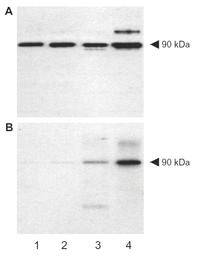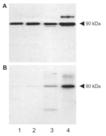Replaces Prod. #: BML-BA1711
Product Details
| Clone: | 7D11 |
| |
| Host: | Mouse |
| |
| Isotype: | IgG2a |
| |
| Immunogen: | Recombinant human β-catenin. |
| |
| UniProt ID: | P35222 |
| |
| Species reactivity: | Human, Mouse
Dog
|
| |
| Specificity: | Recognizes the N-terminus (exon 2) of human, mouse, rat (weak) and dog β-catenin. |
| |
| Applications: | ELISA, IHC, IP, WB
|
| |
| Recommended Dilutions/Conditions: | Western Blot (0.5µg/ml for HRPO/ECL detection)
Suggested dilutions/conditions may not be available for all applications.
Optimal conditions must be determined individually for each application. |
| |
| Positive Control: | Included. (Prod. No. ALX-840-027) |
| |
| Purity Detail: | Thiophilic adsorption and size exclusion chromatography purified. |
| |
| Formulation: | Lyophilized from 1ml of 2x PBS containing 0.09% sodium azide, PEG, and sucrose. |
| |
| Reconstitution: | Reconstitute with 1ml water (15 minutes at room temperature). |
| |
| Use/Stability: | Stable at -80°C up to 1 year, at 4°C up to 3 months. |
| |
| Handling: | Avoid freeze/thaw cycles. After reconstitution, prepare aliquots and freeze in liquid nitrogen. |
| |
| Shipping: | Blue Ice |
| |
| Long Term Storage: | -20°C |
| |
| Protocol: | Recommended blocking buffer CPPT: 10mM TRIS-HCl, pH 7.4, 0.5% (w/v) casein, 1% (w/v) PEG 4,000, 1% (w/v) polyvinylpyrrolidone, 0.1% (v/v) Tween 20, 150mM sodium chloride. |
| |
| Regulatory Status: | RUO - Research Use Only |
| |

Figure A: Western blot analysis of recombinant β-catenin from E. coli (mainly depospho-β-catenin) using various antibodies.
Figure B: Western blot analysis of lysate of pervanadate-treated SKOV-3 cells (phospho- and dephospho-β-catenin) using various antibodies.
Method: β-catenin probes were applied to SDS-PAGE, transferred to PVDF membranes, probed for 1 hour at 15-22°C with the indicated MAbs (0.5µg/ml) and developed with ECL (exposure time 5 sec.). Antibodies used are:
Lane 1: MAb to β-Catenin (dephospho, aa 35-50) (7A7) (Prod. No. ALX-804-259)
Lane 2: MAb to β-Catenin (NT/Exon 2) (7D11) (Prod. No. ALX-804-060)
Lane 3: MAb to β-Catenin (dephospho, aa 27-37) (8E4) (Prod. No. ALX-804-260)
Lane 4: MAb to β-Catenin (Exon 3) (9G2) (Prod. No. ALX-804-058)
Please mouse over
Product Literature References
GATA3 mediates nonclassical β-catenin signaling in skeletal cell fate determination and ectopic chondrogenesis: T. Maruyama, et al.; Sci. Adv.
8, eadd6172 (2022),
Abstract;
STAT3 paradoxically stimulates β‐catenin expression but inhibits β‐catenin function: S. Ibrahem, et al.; Int. J. Exp. Pathol.
95, 392 (2014),
Abstract;
Relation between expression pattern of wild-type p53 and multidrug resistance proteins in human nephroblastomas: I. Hodorova, et al.; Acta Histochem.
115, 273 (2013),
Application(s): Immunohistochemistry of human tissue,
Abstract;
Phospho-beta-catenin accumulation in Alzheimer's disease and in aggresomes attributable to proteasome dysfunction: M. Ghanevati & C.A. Miller; J. Mol. Neurosci.
25, 79 (2005),
Abstract;
The human F box protein beta-Trcp associates with the Cul1/Skp1 complex and regulates the stability of beta-catenin: E. Latres, et al.; Oncogene
18, 849 (1999),
Abstract;
Abnormal immunoreactivity of the E-cadherin-catenin complex in gastric carcinoma: relationship with patient survival: A. Jawhari, et al.; Gastroenterology
112, 46 (1997),
Abstract;
beta-catenin is a target for the ubiquitin-proteasome pathway: H. Aberle, et al.; EMBO J.
16, 3797 (1997),
Abstract;
Beta-catenin mutations in cell lines established from human colorectal cancers: M. lyas, et al.; Proc. Natl. Acad. Sci. USA
94, 10330 (1997),
Abstract;
Functional interaction of beta-catenin with the transcription factor LEF-1: J. Behrens, et al.; Nature
382, 638 (1996),
Abstract;
XTcf-3 transcription factor mediates beta-catenin-induced axis formation in Xenopus embryos: M. Molenaar, et al.; Cell
86, 391 (1996),
Abstract;
Regulation of intracellular beta-catenin levels by the adenomatous polyposis coli (APC) tumor-suppressor protein: S. Munemitsu, et al.; Proc. Natl. Acad. Sci. USA
92, 3046 (1995),
Abstract;
Beta-catenin mediates the interaction of the cadherin-catenin complex with epidermal growth factor receptor: H. Hoschuetzky, et al.; J. Cell Biol.
127, 1375 (1994),
Abstract;
Responses to Wnt signals in vertebrate embryos may involve changes in cell adhesion and cell movement: R.T. Moon, et al.; J. Cell Sci. Suppl.
17, 183 (1993),
Abstract;
The product of the Drosophila segment polarity gene armadillo is part of a multi-protein complex resembling the vertebrate adherens junction: M. Peifer; J. Cell Sci.
105, 993 (1993),
Abstract;













